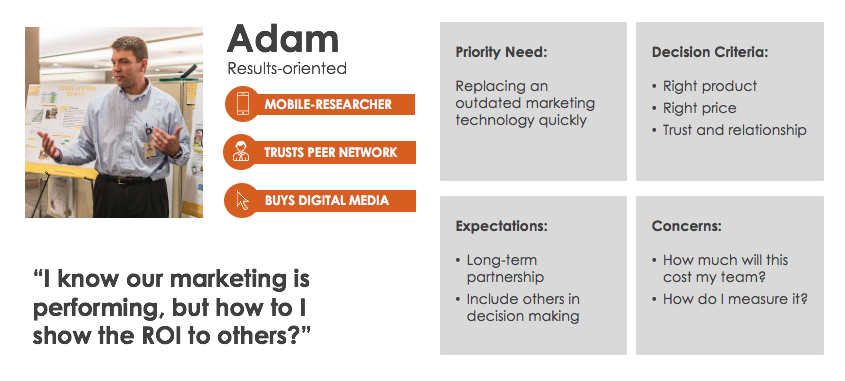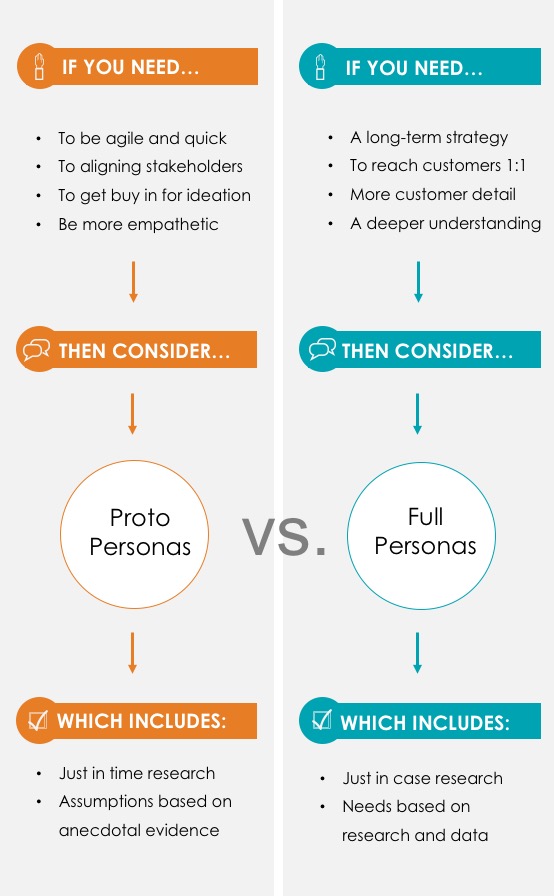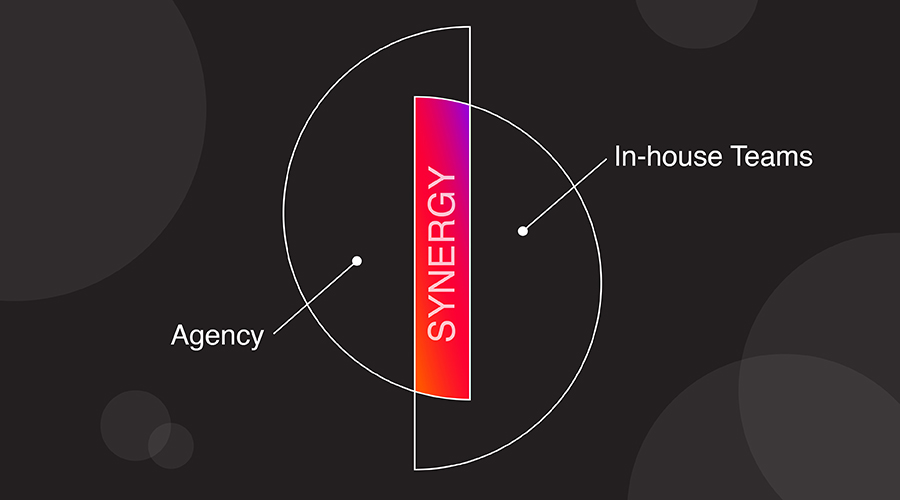Today’s marketers are facing unprecedented challenges in keeping up with rapidly changing marketplaces, shifting consumer appetites and understanding the needs of new customers with different demands.
If you’re a marketer trying to position yourself in sectors where attitudes may be changing and newer customers are no longer responsive to traditional ways of doing business (spoiler alert: that’s pretty much everybody), building personas is the best place to start. We as marketers have focused a lot of our energy on being agile and experimenting, but there is still more opportunity you may be missing. Now’s the time to slow down and conduct research to understand the gaps, the competition and the unfulfilled needs of these new audiences. One way to take the guesswork out of how to focus your message and marketing efforts is to develop personas.
“The aim of marketing is to know and understand the customer so well the product or service fits him and sells itself.”
– Peter Drucker, 1973
Where to Start?
But we’re not here to sell you on the need for personas. (We’ve done that in a previous article.) What we’re here to talk about, is once your marketing organization is ready to go down the road of persona building, where do you start?
There are multiple factors that go into your plan for persona building: time, budget, goals, audience, etc. And while there is no bulletproof solution to understanding an audience’s needs when shifting a product’s direction, launching a new service or trying to differentiate a business from the competition, there are formulas that B2B markers can use to decide how much research (and associated spend) is needed to meet your business goals.
Let’s start by talking about the two types of personas that Simantel recommends for clients.
Not All Personas Are Created Equal
The two types of personas to consider are proto (provisional) personas and full personas. Each has its place in marketing, and aspects like business objectives, time, budget and current state knowledge all come into play when making a recommendation on personas.
Proto Persona
When you’re looking for predictability, simplicity and speed, we recommend using the provisional persona, a form of just-in-time research.
The proto persona is your best guess at understanding who is using (or will be using) products and services and why.
These personas are ideal when time is of the essence and it’s more important to define specific details instead of being exact and precise. A proto persona can even be developed in a matter of hours and serves as the launchpad for deeper user understanding to fuel product or service line development or create shared understanding of an audience across multiple departments and use cases.
With proto personas, you strive to identify fundamental problems that an audience needs to solve and ensure that every proposed solution and communication goal is 100 percent focused on the things that add value toward meeting those needs.
Just-in-time solutions reduce risk in investing in content, service lines and products that fail to realize proposed value for your target users. Below is an example of what a proto persona could look like. I also want to point out a common misconception about these is that many will call it a full persona, when in fact it is a proto persona.

To get started on defining how your audience thinks and feels, download this Empathy Map worksheet that we use with our clients and try it yourself.
Full Persona
Conversely, the full persona is an example of a just-in-case research deliverable. Here you strive to understand the totality of an audience’s problems and needs, the marketplace, competitors and trends.
With full personas you ask questions that cover blind spots, have a deeper understanding of the entire picture of a customer’s world and account not only for what they want now, but what they might want in the future.
This approach helps provide a sound strategic footing for making changes that can require organizational alignment, people and process changes or long-term investments. In short, a full persona aims to understand a variety of things that may be interesting in helping for ideation and providing data you may not need or be able to take immediate action upon for a variety of reasons, but still gives a complete picture of the audience.
They go beyond demographics and behaviors and tell a story, often times including multiple scenarios for each persona that you might address with a product, service or partnership. With full personas, we can start reaching that nirvana of true 1:1 marketing. I’ll be honest though, the need for full personas vs. proto personas is sometimes a difficult conversation to have, mostly due in part to the investment needed for deeper research. Although full personas may cost you more time and money upfront, the long-term influence on your marketing decisions can be highly impactful, and it will show in your ROI. Think of full personas as part of your long-term strategy.
We really wanted to show you an example of what a full persona includes. But because of the deep dive into our client’s audience and the confidentiality around that information, we just can’t show one that we’ve done. (But trust me, our clients loved them).
How to Choose the Right Persona Type
 Deciding which persona is right for you comes down to your needs. Does your organization need audience information that is heavily researched, well thought out and used in presentations and detailed? If so, full personas are the way you should go.
Deciding which persona is right for you comes down to your needs. Does your organization need audience information that is heavily researched, well thought out and used in presentations and detailed? If so, full personas are the way you should go.
Do you need to help align stakeholders on a view of a customer, get buy-in for ideation or help stakeholders and team members be more empathetic to customers? If so, a proto persona can potentially do the job without the cost and time of deep research.
Either way, full personas and proto personas help you:
- Understand your audience
- Visualize and humanize your users to the organization
- Keep everyone on the same page in understanding how a product or service would be used by customers
We recommend using proto personas at a minimum when getting into a new campaign, targeting a new audience or changing something about existing efforts. We typically like to create them alongside our partners in discovery workshops, but the nature of a proto persona being based on intuition and anecdotal evidence means they can be created and recreated at any time.
Whenever alignment is needed across stakeholders, we recommend using proto personas to help frame the group. If additional information or further validation is required to make an investment decision, to write a five-year strategy or to approve a new product or service for production, crafting proto personas is a helpful exercise.
If assurance and deep data are required, we recommend spending the time, effort and budget to develop full, research-backed personas.
The ability to determine market size, understand the nuances of different customer groups and have your approach backed with actual verbatims and qualitative and quantitative data is second to none when it comes to a long-term strategy.
Other Considerations
The important thing to remember is that it does not have to be zero to one hundred. There are many things we can do from a research perspective to better your marketing.
Related: Ready, Set, Research
Start by summarizing some of the common traits you see in your target markets or from pulling existing data, aligning on business objectives and deciding on a broad or narrow scope.
This can be done in a workshop setting where you can understand your goals, identify who you think the audiences are, talk about potential new audiences and sketch out what you think you know about those people.





